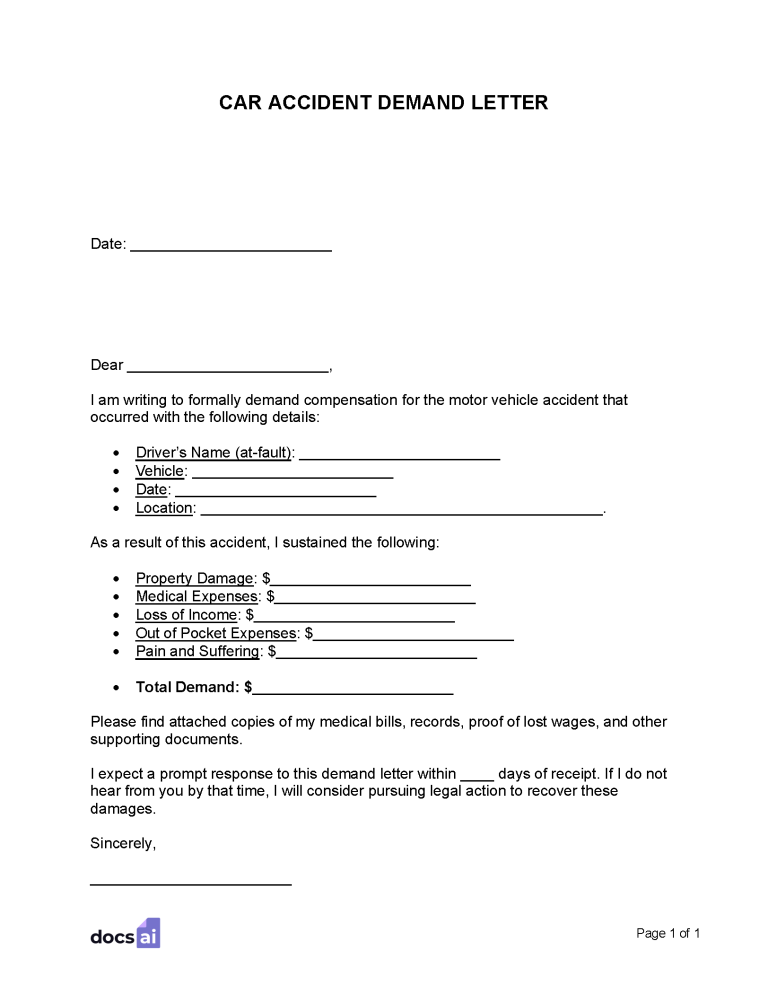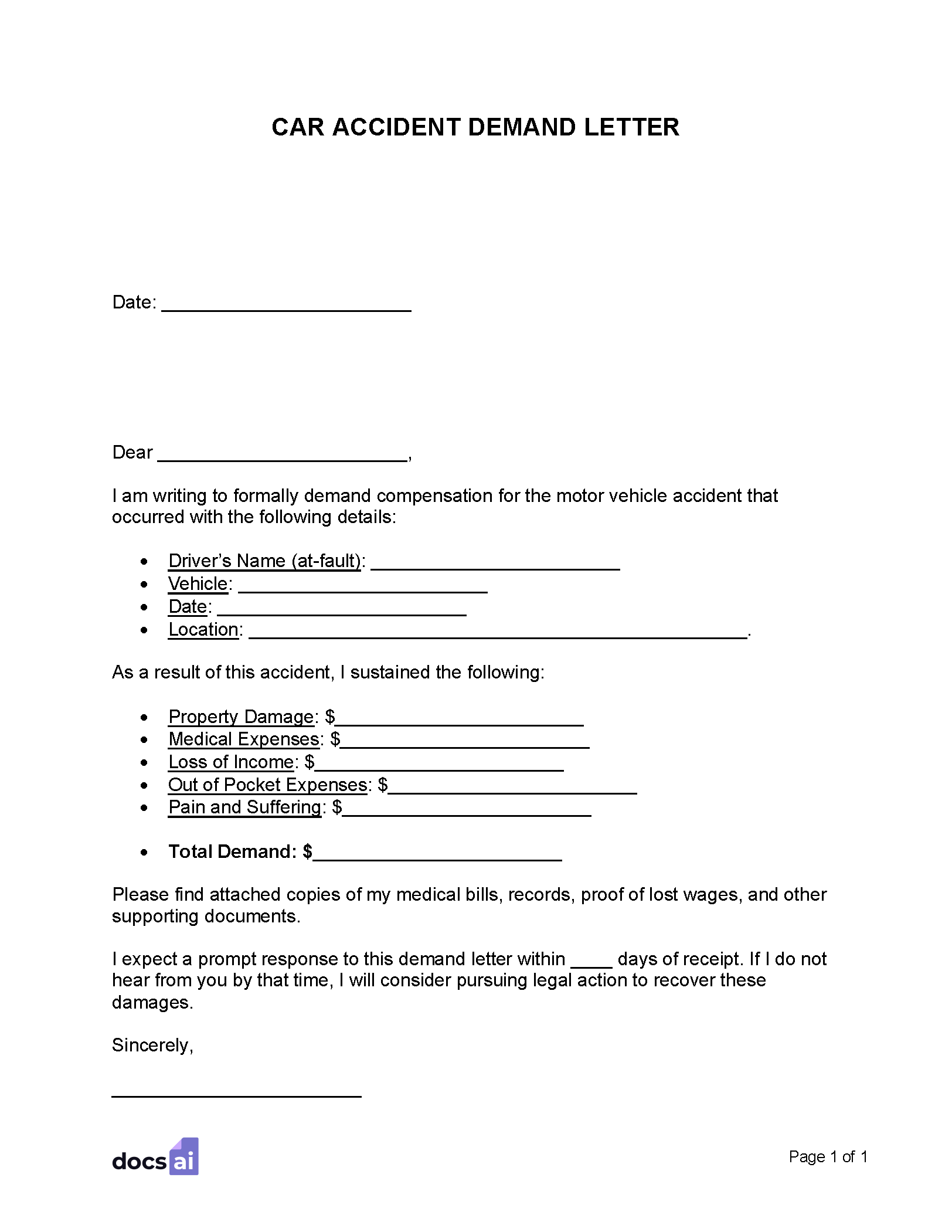Key Features
- Parties’ Information. The names and addresses of the parties involved in the accident, including the at-fault party’s insurance company.
- Car Accident Details. The time and date of the car accident. A police report should be attached as supplemental evidence.
- Medical Injuries. List the details of any injuries incurred, treatments undergone, and medical expenses.
- Lost Wages. Calculate the loss of income due to not being available for work.
- Settlement Offer. An amount that is justified given the total amount of damages.
- Deadline. A deadline for the other party to respond, commonly 10 to 30 days.
How to Send (5 steps)
1. Gather Evidence about the Accident
The claimant should collect the following:
- Police or Accident Report (usually takes 3-5 days to obtain)
- Witness Statements
- Videos or Images of the Damage
- Medical Bills
- Proof of Lost Wages
2. Draft a Demand Letter
Attach the evidence collected to a demand letter which includes:
- Facts about the accident:
- Date
- Location
- Parties Involved
- Who’s at Fault
- Explain why the other driver is at fault.
- Describe personal property damage, injuries sustained, and loss of income.
- Enter the settlement amount requested based on the circumstances.
- Write a deadline by which the recipient must respond (or legal action will occur).
3. Send by Certified Letter
Send the demand letter by certified mail with the requested return receipt (via USPS). This will give proof that the demand letter was received by the recipient.
It should be sent to both the at-fault driver and their insurance company.
4. Wait for a Response
Try to resolve the matter with the breaching party by finding a solution or a settlement. If the breaching party is unresponsive, read the original contract to review the alternative dispute resolution.
5. File Legal Action (if necessary)
If the at-fault driver or their insurance company is not responding, it might be necessary to file a lawsuit. It is recommended that an attorney be contacted to help with the process of getting a settlement.
Sample
CAR ACCIDENT DEMAND LETTER
[CLAIMANT’S NAME]
[STREET ADDRESS]
[CITY, STATE, ZIP CODE]
[E-MAIL ADDRESS]
[PHONE]
Date: [DATE]
[INSURANCE COMPANY’S NAME]
[STREET ADDRESS]
[CITY, STATE, ZIP CODE]
[E-MAIL ADDRESS]
Dear [RECIPIENT’S NAME],
I am writing to formally demand compensation for the motor vehicle accident that occurred with the following details:
- Driver’s Name (at-fault): [DRIVER’S NAME]
- Vehicle: [VEHICLE DESCRIPTION]
- Date: [DATE]
- Location: [LOCATION]
As a result of this accident, I sustained the following:
- Property Damage: $[AMOUNT]
- Medical Expenses: $[AMOUNT]
- Loss of Income: $[AMOUNT]
- Out of Pocket Expenses: $[AMOUNT]
- Pain and Suffering: $[AMOUNT]
- Total Demand: $[AMOUNT]
Please find attached copies of my medical bills, records, proof of lost wages, and other supporting documents.
I expect a prompt response to this demand letter within [#] days of receipt. If I do not hear from you by that time, I will consider pursuing legal action to recover these damages.
Sincerely,
________________________
-
- Medical expenses: Past and future.
- Lost wages: Past and future.
- Property damage: Vehicle and personal property.
- Pain and suffering: Commonly valued between 1x to 5x the medical expenses.
- Loss of consortium: Impact on personal relationships (marriage).
- Out-of-pocket expenses: Any other hardships caused by the accident.
-
- Police Report: To prove the accident actually happened and who is at-fault.
- Crash Evidence: Either from a dash-cam, photos obtained at the scene, and witness statements.
- Medical Bills: List of all invoices and estimates of future treatments because of injuries sustained.
- Loss of Income: Proof of lost income including previous pay stubs, contractor agreements, or other forfeited opportunities.
- Property Damage: Invoices or repair estimates from repair shops.
- Out-of-Pocket Expenses: Receipts from inconveniences due to medical help, not having a vehicle, or any other items.
- Pain and Suffering Documentation: To show examples of pain and suffering by the victim.
-
Yes, a car accident demand letter is simply a written request for compensation due to a collision which can be sent without an attorney.
-
- Simple Claims: 1-3 months. For smaller settlements with no injuries.
- Complex Claims: 3-12 months. larger settlements with injuries.
- Unresponsive Claims: 12+ months. If the insurance company or at-fault driver is being unresponsive, it can take years for lawsuits to resolve and settlements to be paid.
-
An insurance company pays up to the liability amount under the driver’s plan.
However, the driver pays if they are uninsured or for any amount above their liability coverage.


